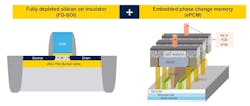Micro Leverages FD-SOI and Phase-Change Memory
What you'll learn:
- What is FD-SOI?
- What is phase-change memory (PCM)?
- Why the STM32V8 can target applications from space to industrial automation.
STMicroelectronics’ (ST) STM32V8 family is designed to handle high-performance, rugged embedded applications that require reliable storage, networking, and basic artificial-intelligence (AI) support. It’s based on an 800-MHz Arm Cortex-85 with Helium/MVE support delivering up to 5,072 EEMBC CoreMarks.
The fully-depleted silicon-on-insulator (FD-SOI) transistors and embedded phase-change memory (ePCM) are two major technologies utilized by the STM32V8 family (Fig. 1).
Micros, FD-SOI, and PCM
FD-SOI isn’t new. SOI has been around for a while. I remember using RCA’s 8-bit silicon-on-sapphire (SOS) 1802 COSMAC device decades ago. One reason for using it involved space applications. Turns out this is also a space where the STM32V8 can be employed.
FD-SOI competes with FinFET, which also provides high-performance operation. It’s relatively new in the microcontroller space and allows the STM32V8 to operate at higher speeds in addition to improving power utilization.
As noted, PCM is the other major component in the systems. PCM has also been around in many forms, including Intel’s discontinued 3D XPoint memory. Designed to be fast, it competes with other embedded non-volatile memory (eNVM) technologies like MRAM and FRAM, as transistor size shrinks make it hard for embedded flash memory to keep up.
ST’s PCM has additional advantages compared to MRAM and FRAM. It works at temperatures up to 140°C. And its radiation immunity and similar attributes make it possible to address space applications as well as very rugged and automotive applications.
The chip family supports up to 4 MB of eNVM storage along with 1.5 MB of RAM. Off-chip serial memory includes Octo-SPI (8-bit) and Hexdeca-SPI (16-bit) interfaces. These support serial NOR flash, Hyper, and PSRAM, as well as eXecute-in-place (XIP) operation.
A Closer Look at the SRM32V8
The chip can incorporate the Chrom-ART graphics accelerator along with a TFT LCD controller and JPEG accelerator (Fig. 2). The Gigabit Ethernet controller supports time-sensitive networking (TSN), which is becoming the standard for industrial and automotive control systems. It also has interfaces like FD-CAN, high-speed USB, and HDMI-CEC (consumer electronics control). There are 12-bit analog-to-digital converter (ADC) and digital-to-analog converter (DAC) interfaces along with a number of audio interfaces, i.e., two SAI and four I2S interfaces.
The system is designed for security from the ground up. This includes secure storage, secure boot, and secure debug support. And each chip has a unique ID and antitamper capability. Also in the mix are PSA Level 3 and SESIP 3 security certifications.
STM32V8 Discovery Kit (STM32V8-DK) is supported by ST’s NanoEDGE AI Studio and STM32Cube.AI that supports frameworks like TensorFlow Lite, Keras, PyTorch, and ONNX (Fig. 3).
Overall, the STM32V8 moves micros into a new realm. ST helped develop the FD-SOI and PCM technologies that will give them a leg up on the competition.
About the Author
William G. Wong
Senior Content Director - Electronic Design and Microwaves & RF
I am Editor of Electronic Design focusing on embedded, software, and systems. As Senior Content Director, I also manage Microwaves & RF and I work with a great team of editors to provide engineers, programmers, developers and technical managers with interesting and useful articles and videos on a regular basis. Check out our free newsletters to see the latest content.
You can send press releases for new products for possible coverage on the website. I am also interested in receiving contributed articles for publishing on our website. Use our template and send to me along with a signed release form.
Check out my blog, AltEmbedded on Electronic Design, as well as his latest articles on this site that are listed below.
You can visit my social media via these links:
- AltEmbedded on Electronic Design
- Bill Wong on Facebook
- @AltEmbedded on Twitter
- Bill Wong on LinkedIn
I earned a Bachelor of Electrical Engineering at the Georgia Institute of Technology and a Masters in Computer Science from Rutgers University. I still do a bit of programming using everything from C and C++ to Rust and Ada/SPARK. I do a bit of PHP programming for Drupal websites. I have posted a few Drupal modules.
I still get a hand on software and electronic hardware. Some of this can be found on our Kit Close-Up video series. You can also see me on many of our TechXchange Talk videos. I am interested in a range of projects from robotics to artificial intelligence.




